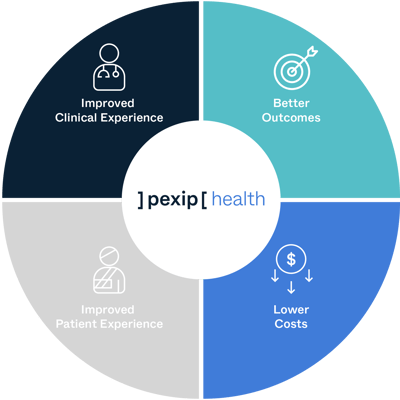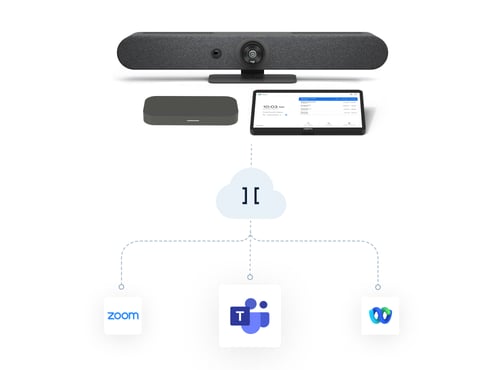Especially in the days of Covid-19, everyone in healthcare is focused on the Quadruple Aim. How can we achieve better outcomes at a lower cost while improving both the clinician and patient experience?
It often feels insurmountable, and now, not only do we need to provide care remotely, but this offer has also become a patient expectation. For the first time since its inception, “Telehealth” is a household word. But what is “Telehealth,” and does it actually result in better outcomes, lower costs, and improved clinician/patient experience?

Just Google the term “Telehealth,” and you’ll get an extensive list of vendors and a lot of variation in definitions. With over 600 vendors in this space from early-stage start-ups to CVS, Walgreens and Amazon, there seems to be a technology for every use case.
It’s very easy to be distracted by the latest shiny object or IPO, but if you’re serious about impacting the Quadruple Aim, let’s talk about reality. I’ll explain how implementing a best-in-class telehealth system across all your organization’s use cases can bring you closer to this goal.
Integrate your telehealth platform with your entire organization for both inpatient and outpatient care
A common mistake some healthcare organizations make when investing in telehealth is missing the forest for the trees, so to speak, by focusing on telehealth in only a limited part of their operations or as a “technology” solution. This makes telehealth prone to getting stuck in silos with different departments using a variety of technologies and workflows.
This disjointed approach can cause unnecessary complexity, user confusion, compliance risks and ultimately adds to the overall TCO which is in direct conflict of the goal to reduce the costs of care.
The Quadruple Aim is all about combining multiple efforts on a large scale and toward a common goal, meaning the telehealth solution in place must also be consistent, effective, and prepared to serve multiple purposes simultaneously.
A telehealth platform that covers a wide range of use cases, both for inpatient and outpatient care, is necessary for unlocking the full potential of this technology.
Key telehealth use cases: Outpatient care
An article from McKinsey & Company found that around USD 250 billion worth of healthcare services could be virtually enabled in U.S. outpatient, office, and home health applications. That’s 20% of total spending, which is indicative of the potential for telehealth and remote health solutions globally as well.
Key use cases for telehealth in outpatient care and home health include:
- Video and device monitoring
- Routine care
- Remote diagnostics
- Care team coordination
- Occupational, physical and speech therapy
- Medication administration
- Pre- and post-operative care
And the possibilities don’t end there. Just like care in the home, these technologies are being used in “mini-clinics” popping up in retail locations, employee health centers and schools. With minimal staff connected to a broader care delivery system, these services provide quick access to qualified clinicians who are either able to immediately address the concern or direct them to the right level of care.
According to United Health Group, up to two thirds of hospital ED visits are avoidable. At an average of around $2,000/visit, that equates to about $32B in annual costs savings assuming those patients are treated via urgent care of a physician visit. Just the metrics for triage to the appropriate level of care can demonstrate an ROI.
Key telehealth use cases: Inpatient care
The Covid-19 pandemic has also put the spotlight on innovative and efficient new ways of applying telehealth to inpatient care. For instance, many hospitals were forced to quickly create makeshift video carts to enable more widespread use of telehealth and reduce Covid infection risks. Some of the key telehealth use cases in inpatient care have been so successful they will continue into the “new normal” of hybrid care (virtual and in-person healthcare), including:
- Telesitting
- Remote rounding
- Discharge planning and post discharge monitoring
- Specialty consultations
- Virtual family visits
Increasing telehealth use throughout different examples of inpatient care has been shown to generate a cost savings of 19% according to an article in Aging Well. Applying this technology can also significantly help improve efficiencies with emergency department overflow and triaging, and reliable video links for ICU patients can boost clinical outcomes by improving patient experience.
The eICU use case is an example of how telehealth can make a difference both in a patient’s mental well-being (such as with virtual family visits), and even in life-or-death situations, where physicians at other facilities can be consulted remotely on diagnostics or treatment procedures.
The use of telehealth after leaving the hospital has also been shown to be a powerful tool for lowering readmission rates and improving efficiency, especially for patients with chronic conditions. For instance, a study published in Telehealth and Medicine Today found that in the United States, there has been a 73% decrease in readmission rates for COPD patients as a result of telehealth.
By integrating telehealth with your outpatient services, you can provide better, more effective, and cost-efficient care, each a key piece of the Quadruple Aim puzzle.
Telehealth should adapt to your team’s needs, not the other way around
As I’ve demonstrated, deploying telehealth for many different uses is important -- but it’s not necessarily easy. Inpatient nursing staff have different needs than home care providers, and critical eICU has different video bandwidth and performance requirements than coordinating a home care team.
Everyone involved in these use cases have existing workflows, and it would be difficult to drive adoption if everyone had to start from scratch with completely new ways of working.
As your healthcare organization shifts to more digital strategy, it’s critical to remember choosing a flexible telehealth platform capable of supporting existing workflows will ease implementation and user adoption, allowing for deployment at scale.
Improved access to high quality healthcare at the right time brings your team closer to meeting the Quadruple Aim. Learn more about our uniquely interoperable, best-in-class telehealth platform, Pexip Health.
- Healthcare
- Digital transformation
- Video Platform





